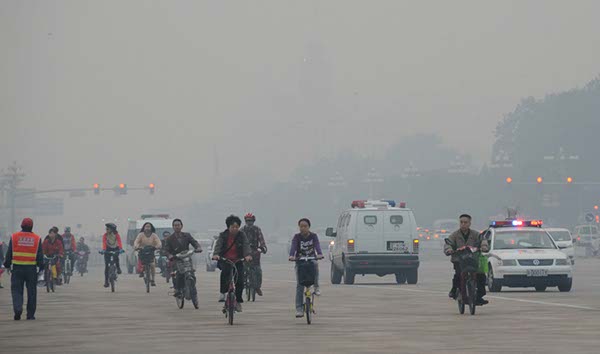Though far fewer vehicles were on the roads during the National Day vacation in Beijing, the city was still blanketed by dense smog on some days, prompting many to doubt the conventional wisdom that the capital's pollution mainly comes from cars.
Though many Beijing residents went to the suburbs during the holiday, resulting in less traffic in urban areas, the Central Meteorological Station warned of heavy pollution on two consecutive days during the seven-day vacation.
 Smoggy days returned to the capital city during the holiday. Zhu Xingxin / China Daily |
"It's hard to define the relationship between smoggy days and automobiles because vehicles that fail to reach the emission standards in Beijing only account for less than 20 percent of total," said John Zeng, director of LMC Automotive Asia Pacific Forecasting.
"These vehicles contributed to more than half of the city's entire automotive emissions. Actually, most of them are commercial vehicles," Zeng said.
He said passenger vehicles just account for a small proportion of total emissions. "They mainly cause traffic congestion instead of air pollution."
He said that city planners mistakenly focus on passenger vehicles as a way to curb pollution.
Some experts say that it's hard to say that smoggy weather has no relation to vehicles.
"Although the urban areas see less traffic during the vacation, looking at highways connecting Beijing to neighboring places, traffic congestion extended for tens of kilometers," said Wang Zifa, a researcher at the Institute of Atmospheric Physics of the Chinese Academy of Sciences.
"Whether the entire emission volume from these vehicles lessened during the vacation requires further statistics and analysis before finding out the origin of smoggy weather," he said.
According to an official at the Beijing Municipal Environment Protection Bureau, international studies have found that vehicles produce the least emissions when at a speed of 60 km/h.
When a car's speed is less than 20 km/h, emissions will triple.
In other words, vehicles produce the most pollution during traffic congestion.
Major reason
Experts pointed out that constant static air conditions in the autumn-to-winter period and pollutants from various sources are the major causes of the recent fog and haze.
Furthermore, the mountains surrounding Beijing trap pollutants in the area.
"About 40 percent of the days in Beijing are not good for diffusing pollutants," Wang said.
According to statistics from the Beijing Municipal Environment Protection Bureau, automobiles accounted for 22.2 percent of Beijing's PM2.5 emissions, while coal burning accounted for 16.7 percent and dust, 15.8 percent.
Zeng said that right now is the peak period of the year when suburban farmers burn straw, which is another important source of smog.
Jia Xinguang, a senior auto analyst in Beijing, pointed out that the reasons for haze days are complicated.
He said most of North China depends largely on coal to make electricity.
Both the burning and transportation of coal produce harmful materials. Neighboring Hebei is also an important coal production province, and coal processing did not halt during the vacation. Experts suggest that city planners solve the smog problem by raising fuel quality and promoting new, clean energies. They also suggest shutting down plants that emit high levels of pollution.
"The entire northern region should work together to solve the pollution problem," Jia said.
